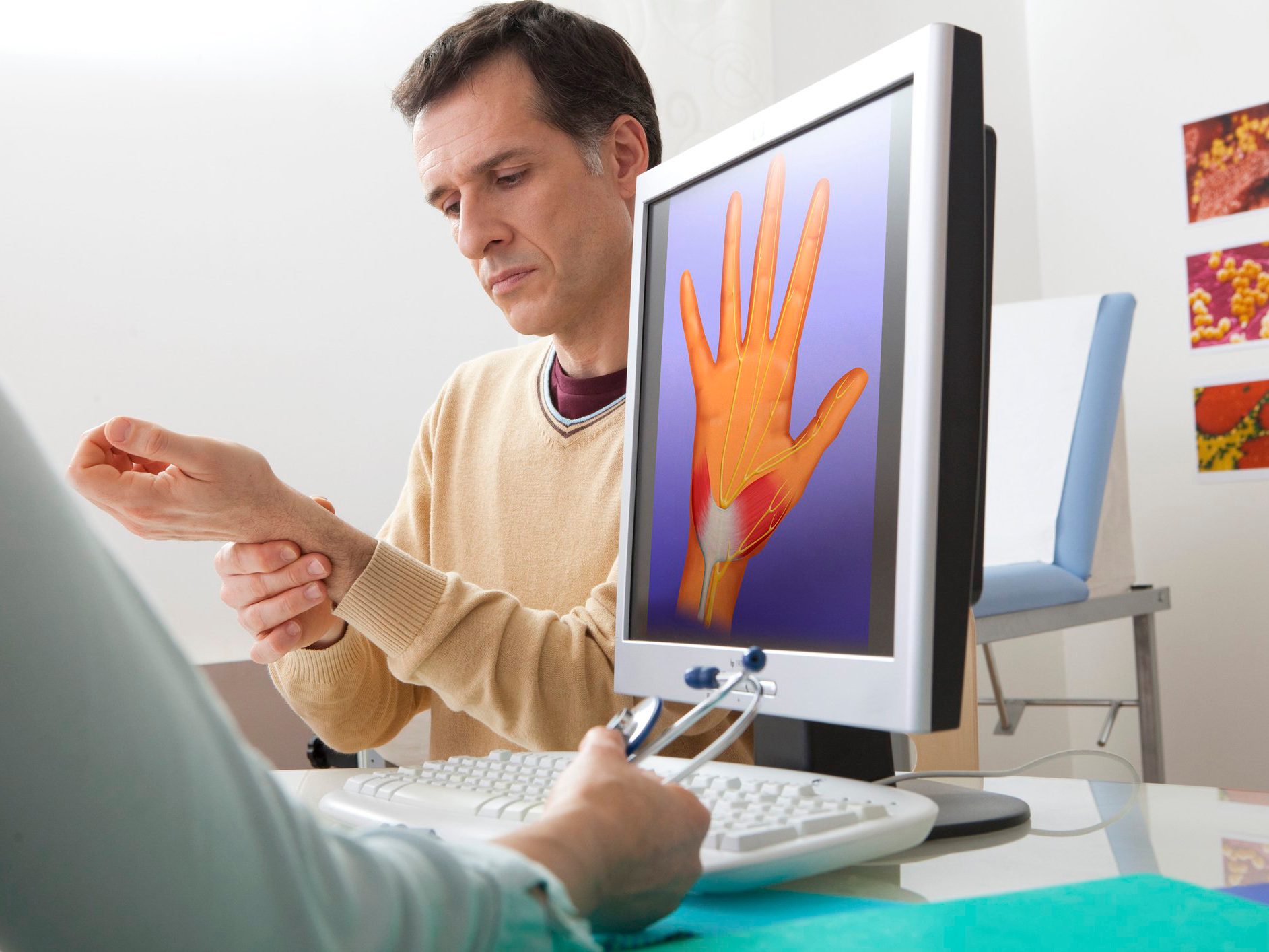What You Need to Know About Carpal Tunnel Syndrome

Here's how to tell if your hand and wrist numbness and tingling may be due to carpal tunnel syndrome, and how this condition is treated.
At the end of the day, you may notice some symptoms like numbness, tingling and weakness in your hands and wrists. This may ring especially true if you spend hours typing on your keyboard, holding your phone as you scroll through social media or even playing an instrument.
It turns out these painful sensations, which are a type of repetitive strain injury, are commonly experienced in many lines of work, and they’re also key traits of carpal tunnel syndrome.
What is carpal tunnel syndrome?
Carpal tunnel syndrome is the name for a collection of symptoms that happen when a major nerve in your hand is squeezed as it travels through your wrist.
The “carpal tunnel” is a small passageway of ligament and bones at the base of your hand that protects the median nerve and tendons that go to your fingers. The median nerve provides feeling to your thumb, index, middle and part of the ring finger (although not the little finger).
It also controls some small muscles at the base of the thumb.
“Imagine the nerve is a hose running through your wrist, carrying energy to your hand and fingers. Now imagine that hose gets a kink in it from being bent repeatedly. That’s how carpal tunnel syndrome starts,” says Eileen Meehan, an occupational therapist and certified hand therapist and an assistant professor of occupational therapy at Touro’s School of Health Sciences in New York City.
“The more the hose gets kinked or the longer the kink stays, the less energy gets through and the more symptoms you experience,” she says. “If you don’t fix the kink in the hose, it can become permanently damaged.”
It doesn’t take much to “kink” the nerve—any time you flex your wrist past 20 degrees you are pinching the carpal tunnel that the nerve runs through, says David Clark Hay, MD, an orthopedic hand and wrist surgeon at Cedars-Sinai Kerlan-Jobe Institute in Los Angeles. (Read about the story of this woman who suffered excruciating pain in her hands for a decade before doctors finally found the cause.)
Carpal tunnel syndrome symptoms
The signs and symptoms of carpal tunnel syndrome can be very subtle at first but it’s important to recognize them immediately. If you can catch the problem early, you have a better chance of reversing or even healing it, Dr. Hay says.
Typical symptoms start with numbness, tingling, and/or pain in your fingers, hand and wrist. “Many patients describe it as a feeling of electricity or ‘shocks’,” Meehan says.
As the syndrome worsens, you may experience more severe pain and weakness in your hand and have trouble pinching your thumb to your fingers, Dr. Hay says.
There are three stages of carpal tunnel syndrome, based on the severity and type of your symptoms, Dr. Hay says.
-
Stage 1: You have intermittent symptoms that may only occur when doing certain activities or when waking in the morning.
-
Stage 2: You feel consistent symptoms on and off during the day and the pain may be severe enough to wake you at night, which is evidence of a mild nerve injury.
-
Stage 3: Your symptoms are always present and in addition, you experience weakness or muscle loss in your thumb, which is evidence of nerve compression.
Carpal tunnel syndrome causes
There are two general causes of carpal tunnel syndrome: The improper positioning of your wrists and the overuse of your hand muscles, Meehan says. It’s often known as a computer problem because it can happen if you are typing and using a mouse for hours at a time. However, carpal tunnel can occur as the result of many different types of activities, she says.
Other common ones include scrolling on a tablet, playing an instrument, using equipment that vibrates (like a jackhammer, vacuum, or lawn equipment), or holding your phone. (Did you know some repetitive motions can also cause eye strain?)
“The most important thing is to figure out which particular activities are the ones causing you pain and those may differ from person to person,” Meehan says. “Once you understand the physiology of what’s happening in your wrist and which activities trigger it, then you can fix it.”
You should also be aware that while all carpal tunnel cases involve hand symptoms, not all hand or wrist issues are caused by carpal tunnel syndrome, says Daniel Curtis, an orthopedic physical therapist and certified manual therapist with Orlando Health in Florida.
“Hand pain, tingling, and numbness may also be caused by elbow, shoulder, neck or back problems so it’s very important to understand the real underlying problem as the treatments will be different from carpal tunnel treatment,” he explains.
Risk factors for carpal tunnel syndrome
While all carpal tunnel syndrome cases come from the same two causes, not all people are equally affected, says Kanu Goyal, MD, an orthopedic hand surgeon at The Ohio State University Wexner Medical Center. Gender plays a role, with three times as many women as men getting carpal tunnel syndrome.
Age is also a risk factor. The older you get, the more wear and tear happens on your wrists and hands, and the more likely you are to experience overuse injuries, Meehan says.
People with certain illnesses or health conditions, like diabetes, obesity, pregnancy and hypothyroidism, are at an increased risk of carpal tunnel syndrome, Dr. Goyal says. While you can’t control your gender or age, you can take steps to manage your overall health.
“Better management of these conditions may help prevent excessive symptoms associated with carpal tunnel syndrome,” he says.
You may also be at a higher risk if you have sustained an injury to your wrist or hand, both recent or in the past, Dr. Curtis says.

Carpal tunnel diagnosis
Diagnosing carpal tunnel syndrome is generally based on the patient’s report of their own symptoms, Dr. Hay says. Your doctor may order a nerve conduction study—a type of test that uses electrodes placed on your hand and arm to look at how your nerves and muscles react to stimulation—but this is usually only done to confirm the severity of the problem or to rule out other problems, not to diagnose it, he explains.
Your doctor will likely order other tests to rule out conditions with similar symptoms like diabetic neuropathy (nerve damage due to elevated blood sugar), a pinched nerve in your neck, a tumour or inflammatory arthritis.
“The diagnosis is really about listening to the patient about what types of symptoms they have, how often they’re occurring and how much it’s impacting their ability to live their life,” he says. “From there we can make a treatment plan.”
A diagnosis will likely also include a manual exam where your doctor or a physical therapist has you go through a range of motions and positions to see if they can find what provokes the symptoms, Dr. Curtis says. For instance, a common physical test is to bring your arms in front of your body, fingers pointed down and then press the backs of your hands together for one minute.
“These special tests can help us determine if the problem is really due to compression of the nerve in the wrist or if it is caused by something higher up the chain, like a neck injury,” he says.
Body awareness is an important component for getting an accurate diagnosis, Meehan says.
“Too many people think wrist or hand pain isn’t a big deal and will try to ignore it. You need to pay attention to what exactly is causing you pain, how long the pain lasts and where it is occurring, even if it seems slight,” she says. “This is all information your medical team needs to help you.”
Carpal tunnel treatments
Treatment for carpal tunnel syndrome depends on the severity of the condition. Mild symptoms can typically be managed with home remedies while surgery may be an option for those who have severe median nerve damage.
It’s important to discuss with your healthcare provider to weigh what options are best for you and your lifestyle.
Home treatments
Home treatments for carpal tunnel syndrome fall into two main categories: Changing your habits to reduce whatever is causing the pain and supporting your wrist while it heals, Dr. Goyal says.
“Carpal tunnel syndrome, in my opinion, can first be best managed with proper ergonomics during activities of daily living,” he says. “Specifically it is best to avoid excessive and prolonged positions of wrist flexion or extension.”

Wear a wrist brace
One of the most important things you can do to help your carpal tunnel syndrome is to start wearing a wrist splint or brace to keep your hand and wrist in a neutral position, Dr. Goyal says.
“Often, patients will have excessive symptoms at night so I recommend sleeping with the splint on,” he says. “Wrist splints may also be worn during the day as well as needed during activities that cause the symptoms.”
For the best results, Meehan recommends having a custom brace made to fit your arm but you can also buy a wrist brace online or in just about any pharmacy and still get good results, she says.
Change your habits
Our society wants quick fixes but if you want to truly heal your carpal tunnel syndrome you need to change your daily habits that are contributing to your problem, Dr. Curtis says. So if you have a job that requires a lot of hand use then you need to find ways to use your hands less at home and when doing your hobbies.
This may mean finding a different way to hold your steering wheel, limiting your time playing video games, sleeping in a different position, holding your child in a different way, learning a new way to hold a knife when chopping food or using electric instead of manual tools for home projects.
“This is often the hardest part for patients but it will give you the best long-term results,” he says.
Ergonomic equipment
Once you’ve identified the cause of your carpal tunnel symptoms, it’s incredibly important to take steps to fix your physical environment, Meehan says.
For instance, if your pain comes from typing for hours on your laptop, it may be helpful to invest in a desk and chair that allow you to position your arms at a better angle or a computer mouse that gives your wrist a break.
An occupational therapist can help you identify your trouble spots and come up with solutions for your particular issues.
Use assistive tools
Another way to reduce the compression on your nerves and allow them to heal is to look for workarounds for common hand-intensive activities, Meehan says.
So for people who have pain when using their phone, they could buy a ring grip that allows them to hold the phone without bending their wrist, use the voice-to-text option instead of typing with their fingers and use a stylus instead of a finger for scrolling.
Take frequent breaks
In an ideal world, you’d be able to simply stop whatever repetitive motion is causing your pain but for many people, it’s an integral part of their job.
One way to help manage this issue is to take frequent “wrist rest” breaks, Dr. Curtis says. Set a timer on your phone every hour to remind yourself to stop what you’re doing or change activities.
Ibuprofen
Part of what causes the problem is inflammation so taking a non-steroidal anti-inflammatory medication, like ibuprofen (Advil), can help manage your symptoms and reduce the pain from carpal tunnel syndrome, Dr. Hay says.
Note that this does not fix the underlying problems of poor wrist position or hand overuse so it’s not an effective treatment on its own, he adds. If you find yourself needing to take pain medication regularly it’s time to talk to your doctor about different treatment options.
Don’t push through pain
“Carpal tunnel syndrome is very treatable if we catch it in the early stages but it can do permanent damage if you let it go too long,” Dr. Hay says.
Pain is your body’s signal that something is wrong so don’t try to push through it and be honest with your doctor about the severity of your symptoms, he adds.
Gentle stretches
There aren’t any exercises to help carpal tunnel syndrome because the problem is that you’re already using your hand too much—adding exercises on top of your daily activities can make the problem worse, Meehan says.
However, taking breaks several times a day to gently stretch out your hands and wrists can be beneficial and provide some pain relief, particularly if you are wearing braces, she says. You might consider starting with these carpal tunnel stretches from Alberta Health Services.
Maintain a healthy weight
“Obesity and weight-related disorders have been linked to carpal tunnel syndrome and therefore keeping your weight under control may help prevent and reduce symptoms from carpal tunnel syndrome,” Dr. Goyal says. (Make sure to incorporate these anti-inflammatory foods that reduce pain.)
Medical treatments
Surgery
Surgery is the only way to correct a severe case of carpal tunnel syndrome, Dr. Hay says. “Once you’re in stage three, there’s physical damage to your nerves and muscles that needs to be physically corrected through surgery,” he explains.
“Surgery allows us to take the pressure off the nerve and by taking the pressure off the nerve, we stop the damage that is occurring to the nerve and allow the nerve to recover,” Dr. Goyal says.
Don’t let the idea of surgery scare you. “The good news is that carpal tunnel surgery these days is minimally invasive, has a quick recovery, and is usually successful,” Dr. Hay says. “Ninety-five percent of patients get at least 95 percent relief, with some seeing a total resolution of their symptoms.”
There are two types of carpal tunnel release surgery: Endoscopic surgery done through the wrist crease or an open release surgery done through an incision in the wrist. Both surgeries are similarly effective, Dr. Hay says.
“The surgery usually takes only about ten minutes, can be done with the patient awake, and only requires skin to heal, which is complete at two weeks,” Dr. Goyal says. You may have a couple of stitches and have some pain or soreness, particularly at the incision site, but you’ll be able to start using your hand within a couple of days and should be fully recovered within two to four weeks, Dr. Hay says.
Steroid injections
If you’d like to try a less invasive option than surgery but need more relief than home treatments provide, a steroid/cortisone injection into the carpal tunnel can be an effective treatment for patients who have mild or moderate symptoms that are intermittent in nature and have been present for less than a year, Dr. Goyal says.
Additional resources
Carpal tunnel syndrome can be troublesome to deal with, especially if your occupation requires repetitive motions with your hand and wrist. However, lifestyle changes can help alleviate numbness, tingling, and weakness.
If your pain is too severe, it’s best to talk with your doctor to determine the best treatment plan for your needs. For more help and information about carpal tunnel syndrome, consider the following resources:






